## 42 常用的 Lambda 表达式使用场景解析和应用
## 引导语
我们日常工作中,Lambda 使用比较多的场景,就是 List 或 Map 下的 Lambda 流操作,往往几行代码可以帮助我们实现多层 for 循环嵌套的复杂代码,接下来我们把 Lambda 流的常用方法用案列讲解一下。
### 1 数据准备
本文演示的所有代码都在 demo.eight.LambdaExpressionDemo 中,首先我们需要准备一些测试的数据,如下:
```
@Data // 学生数据结构 class StudentDTO implements Serializable { private static final long serialVersionUID = -7716352032236707189L; public StudentDTO() { } public StudentDTO(Long id, String code, String name, String sex, Double scope, List<Course> learningCources) { this.id = id; this.code = code; this.name = name; this.sex = sex; this.scope = scope; this.learningCources = learningCources; }
/** * id */ private Long id; /** * 学号 唯一标识 */ private String code; /** * 学生名字 */ private String name; /** * 性别 */ private String sex; /** * 分数 */ private Double scope; /** * 要学习的课程 */ private List<Course> learningCources; } @Data // 课程数据结构 class Course implements Serializable {
private static final long serialVersionUID = 2896201730223729591L; /** * 课程 ID */ private Long id; /** * 课程 name */ private String name; public Course(Long id, String name) { this.id = id; this.name = name; } } // 初始化数据 private final List<StudentDTO> students = new ArrayList<StudentDTO>(){ { // 添加学生数据 add(new StudentDTO(1L,"W199","小美","WM",100D,new ArrayList<Course>(){ { // 添加学生学习的课程 add(new Course(300L,"语文")); add(new Course(301L,"数学")); add(new Course(302L,"英语")); } })); add(new StudentDTO(2L,"W25","小美","WM",100D,Lists.newArrayList())); add(new StudentDTO(3L,"W3","小名","M",90D,new ArrayList<Course>(){
{ add(new Course(300L,"语文")); add(new Course(304L,"体育")); } })); add(new StudentDTO(4L,"W1","小蓝","M",10D,new ArrayList<Course>(){ { add(new Course(301L,"数学")); add(new Course(305L,"美术")); } })); } };
```
请大家稍微看下数据结构,不然看下面案例跑出来的结果会有些吃力。
### 2 常用方法
#### 2.1 Filter
Filter 为过滤的意思,只要满足 Filter 表达式的数据就可以留下来,不满足的数据被过滤掉,源码如下图:

我们写了一个 demo,如下:
```
public void testFilter() { // list 在下图中进行了初始化 List<String> newList = list.stream() // 过滤掉我们希望留下来的值 // StringUtils.equals(str,"hello") 表示我们希望字符串是 hello 能留下来 // 其他的过滤掉 .filter(str -> StringUtils.equals(str, "hello")) // Collectors.toList() 帮助我们构造最后的返回结果 .collect(Collectors.toList()); log.info("TestFilter result is {}", JSON.toJSONString(newList)); }
```
运行结果如下:
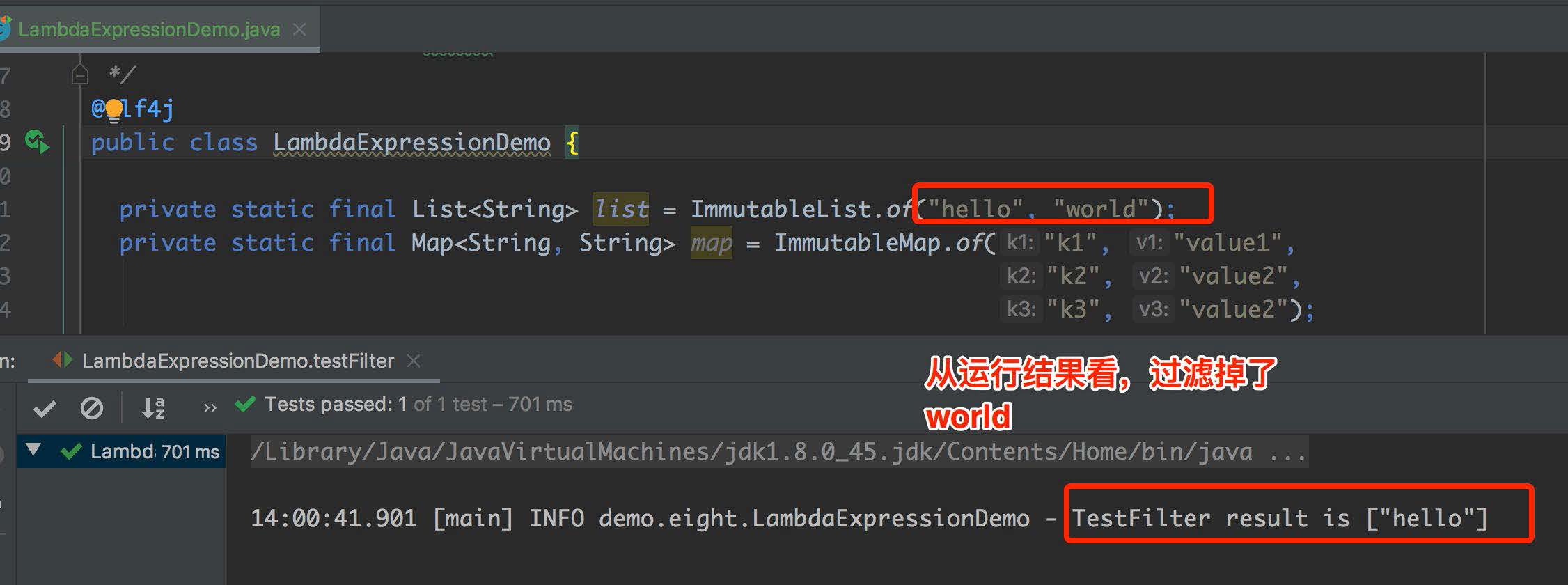
#### 2.2 map
map 方法可以让我们进行一些流的转化,比如原来流中的元素是 A,通过 map 操作,可以使返回的流中的元素是 B,源码如下图:

我们写了一个 demo,如下:
```
public void testMap() { // 得到所有学生的学号 // 这里 students.stream() 中的元素是 StudentDTO,通过 map 方法转化成 String 的流 List<String> codes = students.stream() //StudentDTO::getCode 是 s->s.getCode() 的简写 .map(StudentDTO::getCode) .collect(Collectors.toList()); log.info("TestMap 所有学生的学号为 {}", JSON.toJSONString(codes)); } // 运行结果为:TestMap 所有学生的学号为 ["W199","W25","W3","W1"]
```
#### 2.3 mapToInt
mapToInt 方法的功能和 map 方法一样,只不过 mapToInt 返回的结果已经没有泛型,已经明确是 int 类型的流了,源码如下:
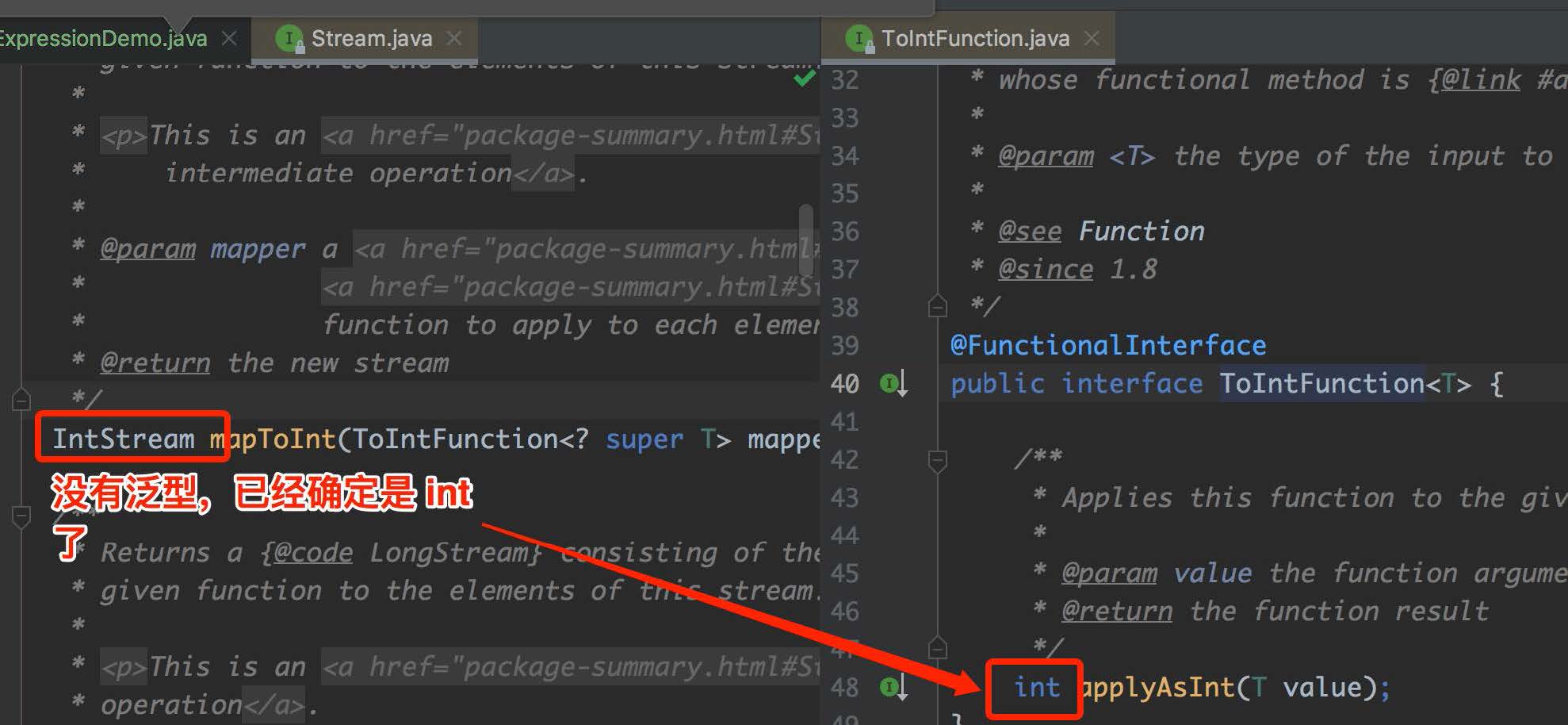
我们写了一个 demo,如下:
```
public void testMapToInt() { List<Integer> ids = students.stream() .mapToInt(s->Integer.valueOf(s.getId()+"")) // 一定要有 mapToObj,因为 mapToInt 返回的是 IntStream,因为已经确定是 int 类型了 // 所有没有泛型的,而 Collectors.toList() 强制要求有泛型的流,所以需要使用 mapToObj // 方法返回有泛型的流 .mapToObj(s->s) .collect(Collectors.toList()); log.info("TestMapToInt result is {}", JSON.toJSONString(ids)); // 计算学生总分 Double sumScope = students.stream() .mapToDouble(s->s.getScope()) // DoubleStream/IntStream 有许多 sum(求和)、min(求最小值)、max(求最大值)、average(求平均值)等方法
.sum(); log.info("TestMapToInt 学生总分为: is {}", sumScope); }
```
运行结果如下:
```
TestMapToInt result is [1,2,3,4] TestMapToInt 学生总分为: is 300.0
```
#### 2.4 flatMap
flatMap 方法也是可以做一些流的转化,和 map 方法不同的是,其明确了 Function 函数的返回值的泛型是流,源码如下:

写了一个 demo,如下:
```
public void testFlatMap(){ // 计算学生所有的学习课程,flatMap 返回 List<课程> 格式 List<Course> courses = students.stream().flatMap(s->s.getLearningCources().stream()) .collect(Collectors.toList()); log.info("TestMapToInt flatMap 计算学生的所有学习课程如下 {}", JSON.toJSONString(courses)); // 计算学生所有的学习课程,map 返回两层课程嵌套格式 List<List<Course>> courses2 = students.stream().map(s->s.getLearningCources()) .collect(Collectors.toList()); log.info("TestMapToInt map 计算学生的所有学习课程如下 {}",
JSON.toJSONString(courses2)); List<Stream<Course>> courses3 = students.stream().map(s->s.getLearningCources().stream()) .collect(Collectors.toList()); log.info("TestMapToInt map 计算学生的所有学习课程如下 {}", JSON.toJSONString(courses3)); }
```
运行结果如下:
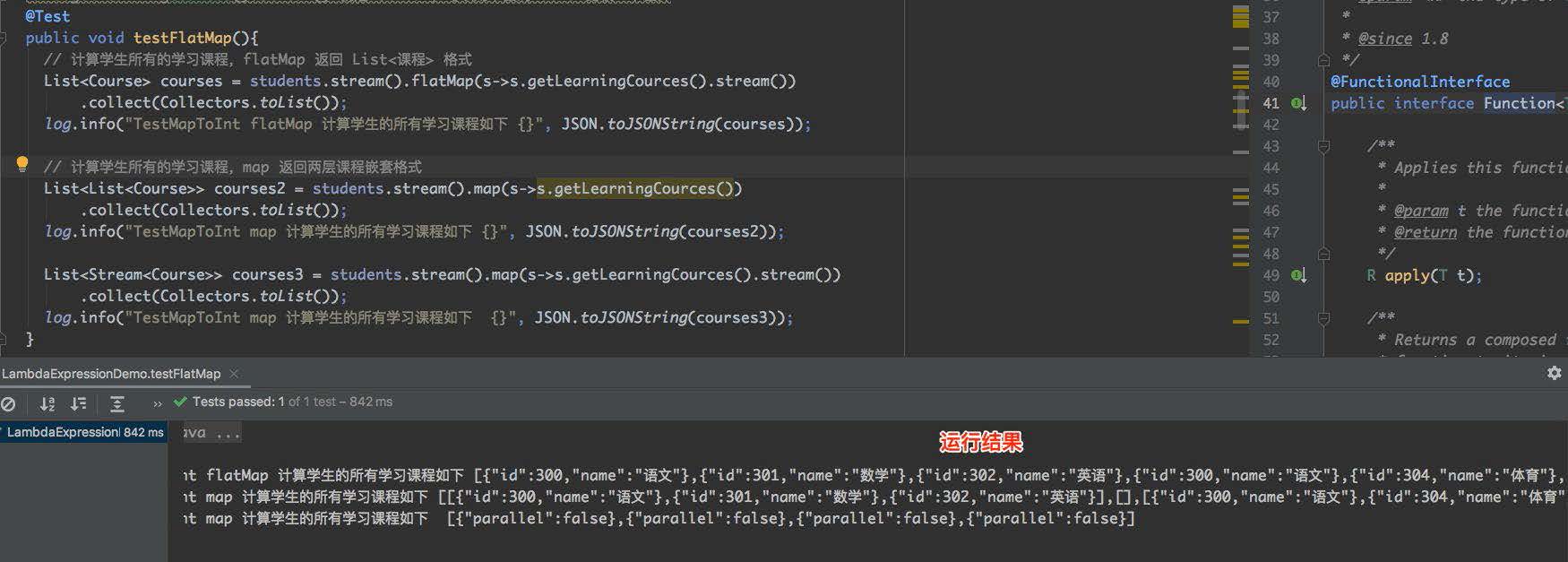
#### 2.5 distinct
distinct 方法有去重的功能,我们写了一个 demo,如下:
```
public void testDistinct(){ // 得到学生所有的名字,要求是去重过的 List<String> beforeNames = students.stream().map(StudentDTO::getName).collect(Collectors.toList()); log.info("TestDistinct 没有去重前的学生名单 {}",JSON.toJSONString(beforeNames)); List<String> distinctNames = beforeNames.stream().distinct().collect(Collectors.toList()); log.info("TestDistinct 去重后的学生名单 {}",JSON.toJSONString(distinctNames));
// 连起来写 List<String> names = students.stream() .map(StudentDTO::getName) .distinct() .collect(Collectors.toList()); log.info("TestDistinct 去重后的学生名单 {}",JSON.toJSONString(names)); }
```
运行结果如下:
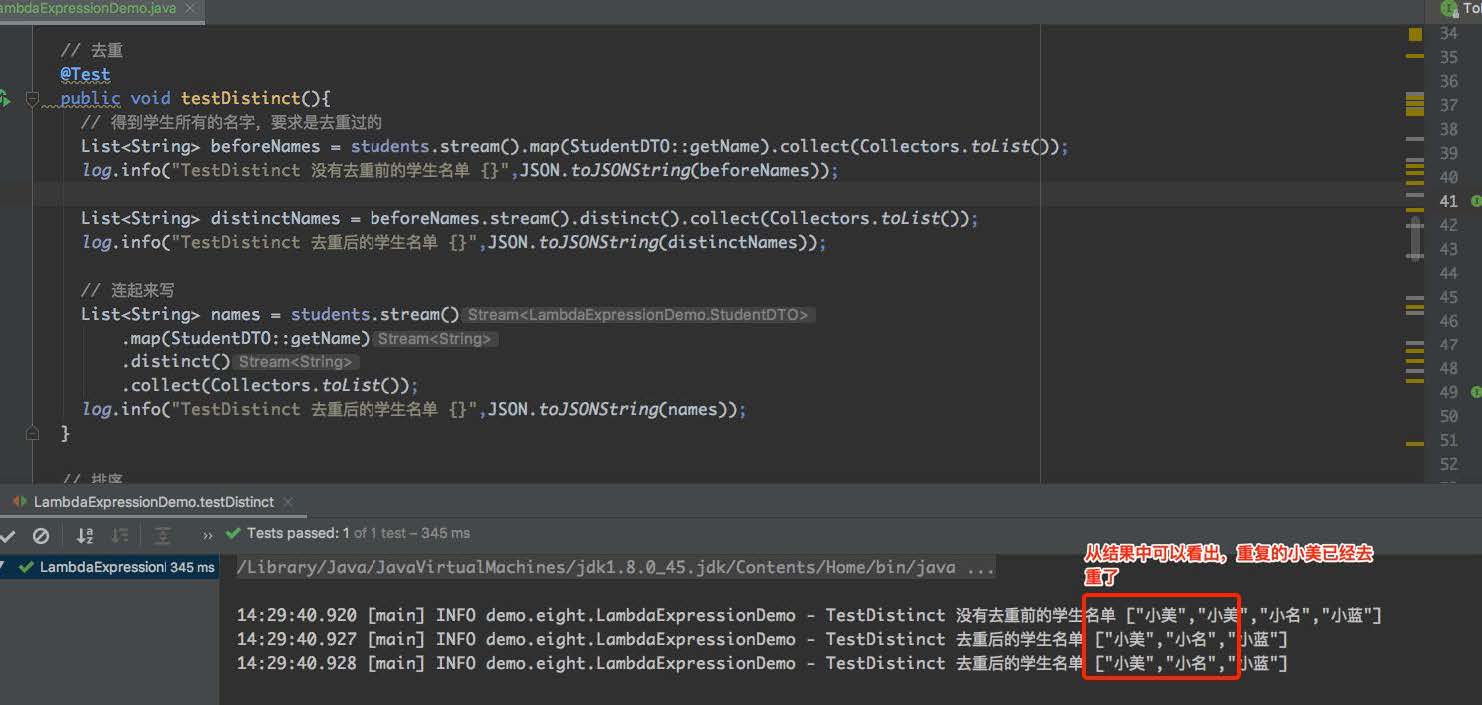
#### 2.6 Sorted
Sorted 方法提供了排序的功能,并且允许我们自定义排序,demo 如下:
```
public void testSorted(){ // 学生按照学号排序 List<String> beforeCodes = students.stream().map(StudentDTO::getCode).collect(Collectors.toList()); log.info("TestSorted 按照学号排序之前 {}",JSON.toJSONString(beforeCodes)); List<String> sortedCodes =
beforeCodes.stream().sorted().collect(Collectors.toList()); log.info("TestSorted 按照学号排序之后 is {}",JSON.toJSONString(sortedCodes)); // 直接连起来写 List<String> codes = students.stream() .map(StudentDTO::getCode) // 等同于 .sorted(Comparator.naturalOrder()) 自然排序 .sorted() .collect(Collectors.toList()); log.info("TestSorted 自然排序 is {}",JSON.toJSONString(codes)); // 自定义排序器 List<String> codes2 = students.stream() .map(StudentDTO::getCode) // 反自然排序 .sorted(Comparator.reverseOrder()) .collect(Collectors.toList()); log.info("TestSorted 反自然排序 is {}",JSON.toJSONString(codes2)); }
```
运行结果如下:

#### 2.7 peek
peek 方法很简单,我们在 peek 方法里面做任意没有返回值的事情,比如打印日志,如下:
```
students.stream().map(StudentDTO::getCode) .peek(s -> log.info("当前循环的学号是{}",s)) .collect(Collectors.toList());
```
#### 2.8 limit
limit 方法会限制输出值个数,入参是限制的个数大小,demo 如下:
```
public void testLimit(){ List<String> beforeCodes = students.stream().map(StudentDTO::getCode).collect(Collectors.toList()); log.info("TestLimit 限制之前学生的学号为 {}",JSON.toJSONString(beforeCodes)); List<String> limitCodes = beforeCodes.stream() .limit(2L) .collect(Collectors.toList()); log.info("TestLimit 限制最大限制 2 个学生的学号 {}",JSON.toJSONString(limitCodes)); // 直接连起来写 List<String> codes = students.stream() .map(StudentDTO::getCode) .limit(2L) .collect(Collectors.toList()); log.info("TestLimit 限制最大限制 2 个学生的学号 {}",JSON.toJSONString(codes)); }
```
输出结果如下:

#### 2.9 reduce
reduce 方法允许我们在循环里面叠加计算值,我们写了 demo 如下:
```
public void testReduce(){ // 计算一下学生的总分数 Double sum = students.stream() .map(StudentDTO::getScope) // scope1 和 scope2 表示循环中的前后两个数 .reduce((scope1,scope2) -> scope1+scope2) .orElse(0D); log.info("总成绩为 {}",sum); Double sum1 = students.stream() .map(StudentDTO::getScope) // 第一个参数表示成绩的基数,会从 100 开始加 .reduce(100D,(scope1,scope2) -> scope1+scope2); log.info("总成绩为 {}",sum1); }
```
运行结果如下:
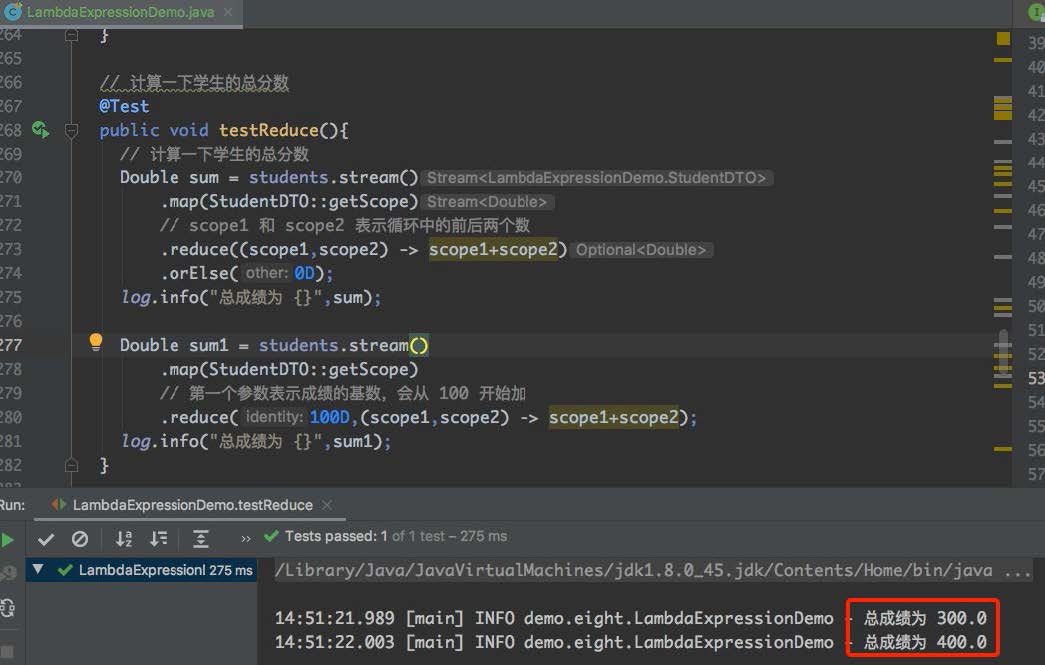
第二个计算出来的总成绩多了 100,是因为第二个例子中 reduce 是从基数 100 开始累加的。
#### 2.10 findFirst
findFirst 表示匹配到第一个满足条件的值就返回,demo 如下:
```
// 找到第一个叫小美同学的 ID @Test public void testFindFirst(){ Long id = students.stream() .filter(s->StringUtils.equals(s.getName(),"小美")) // 同学中有两个叫小美的,这里匹配到第一个就返回 .findFirst() .get().getId(); log.info("testFindFirst 小美同学的 ID {}",id);
// 防止空指针 Long id2 = students.stream() .filter(s->StringUtils.equals(s.getName(),"小天")) .findFirst() // orElse 表示如果 findFirst 返回 null 的话,就返回 orElse 里的内容 .orElse(new StudentDTO()).getId(); log.info("testFindFirst 小天同学的 ID {}",id2); Optional<StudentDTO> student= students.stream() .filter(s->StringUtils.equals(s.getName(),"小天")) .findFirst(); // isPresent 为 true 的话,表示 value != null,即 student.get() != null if(student.isPresent()){ log.info("testFindFirst 小天同学的 ID {}",student.get().getId()); return; } log.info("testFindFirst 找不到名为小天的同学"); }
```
运行结果如下:
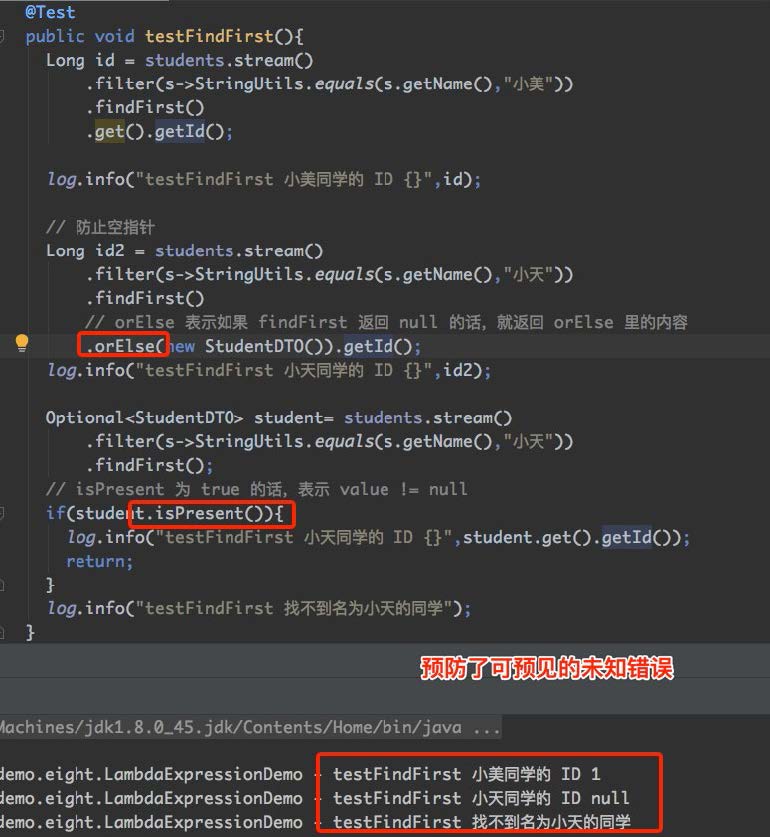
#### 2.11 groupingBy && toMap
groupingBy 是能够根据字段进行分组,toMap 是把 List 的数据格式转化成 Map 的格式,我们写了一个 demo,如下:
```
@Test public void testListToMap(){
// 学生根据名字进行分类 Map<String, List<StudentDTO>> map1 = students.stream() .collect(Collectors.groupingBy(StudentDTO::getName)); log.info("testListToMap groupingBy 学生根据名字进行分类 result is Map<String,List<StudentDTO>> {}", JSON.toJSONString(map1)); // 统计姓名重名的学生有哪些 Map<String, Set<String>> map2 = students.stream() .collect(Collectors.groupingBy(StudentDTO::getName, Collectors.mapping(StudentDTO::getCode,Collectors.toSet()))); log.info("testListToMap groupingBy 统计姓名重名结果 is {}", JSON.toJSONString(map2)); // 学生转化成学号为 key 的 map Map<String, StudentDTO> map3 = students.stream() //第一个入参表示 map 中 key 的取值 //第二个入参表示 map 中 value 的取值 //第三个入参表示,如果前后的 key 是相同的,是覆盖还是不覆盖,(s1,s2)->s1 表示不覆盖,(s1,s2)->s2 表示覆盖 .collect(Collectors.toMap(s->s.getCode(),s->s,(s1,s2)->s1)); log.info("testListToMap groupingBy 学生转化成学号为 key 的 map result is{}", JSON.toJSONString(map3)); }
```
运行结果如下:

### 3 总结
本文我们介绍了 12 种 Lambda 表达式常用的方法,大家可以找到 LambdaExpressionDemo 类,自己 debug 下,这样你在工作中遇到复杂数据结构转化时,肯定会得心应手了。
- 前言
- 第1章 基础
- 01 开篇词:为什么学习本专栏
- 02 String、Long 源码解析和面试题
- 03 Java 常用关键字理解
- 04 Arrays、Collections、Objects 常用方法源码解析
- 第2章 集合
- 05 ArrayList 源码解析和设计思路
- 06 LinkedList 源码解析
- 07 List 源码会问哪些面试题
- 08 HashMap 源码解析
- 09 TreeMap 和 LinkedHashMap 核心源码解析
- 10 Map源码会问哪些面试题
- 11 HashSet、TreeSet 源码解析
- 12 彰显细节:看集合源码对我们实际工作的帮助和应用
- 13 差异对比:集合在 Java 7 和 8 有何不同和改进
- 14 简化工作:Guava Lists Maps 实际工作运用和源码
- 第3章 并发集合类
- 15 CopyOnWriteArrayList 源码解析和设计思路
- 16 ConcurrentHashMap 源码解析和设计思路
- 17 并发 List、Map源码面试题
- 18 场景集合:并发 List、Map的应用场景
- 第4章 队列
- 19 LinkedBlockingQueue 源码解析
- 20 SynchronousQueue 源码解析
- 21 DelayQueue 源码解析
- 22 ArrayBlockingQueue 源码解析
- 23 队列在源码方面的面试题
- 24 举一反三:队列在 Java 其它源码中的应用
- 25 整体设计:队列设计思想、工作中使用场景
- 26 惊叹面试官:由浅入深手写队列
- 第5章 线程
- 27 Thread 源码解析
- 28 Future、ExecutorService 源码解析
- 29 押宝线程源码面试题
- 第6章 锁
- 30 AbstractQueuedSynchronizer 源码解析(上)
- 31 AbstractQueuedSynchronizer 源码解析(下)
- 32 ReentrantLock 源码解析
- 33 CountDownLatch、Atomic 等其它源码解析
- 34 只求问倒:连环相扣系列锁面试题
- 35 经验总结:各种锁在工作中使用场景和细节
- 36 从容不迫:重写锁的设计结构和细节
- 第7章 线程池
- 37 ThreadPoolExecutor 源码解析
- 38 线程池源码面试题
- 39 经验总结:不同场景,如何使用线程池
- 40 打动面试官:线程池流程编排中的运用实战
- 第8章 Lambda 流
- 41 突破难点:如何看 Lambda 源码
- 42 常用的 Lambda 表达式使用场景解析和应用
- 第9章 其他
- 43 ThreadLocal 源码解析
- 44 场景实战:ThreadLocal 在上下文传值场景下的实践
- 45 Socket 源码及面试题
- 46 ServerSocket 源码及面试题
- 47 工作实战:Socket 结合线程池的使用
- 第10章 专栏总结
- 48 一起看过的 Java 源码和面试真题
